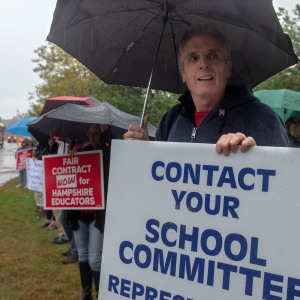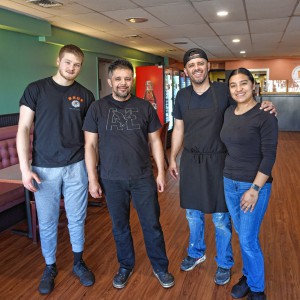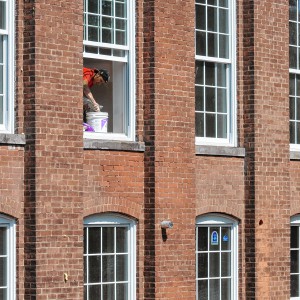Editorial: All aboard for commuter rail study
| Published: 07-13-2017 5:20 PM |
Got a business meeting in Boston Monday morning and want to avoid the traffic jam, time crunch and environmental damage of driving your car solo along the Mass Pike? Wouldn’t it be great to just hop on a high speed train, enjoy a cup of coffee and look at the countryside unfolding along with other west-east Massachusetts commuters?
Best of luck with that.
At this point, the only train leaving Monday morning from our region is the Amtrak Northeast Regional line leaving Springfield at 5:50 a.m. (gulp), requiring you to transfer to another train in New Haven, Connecticut (double gulp) and then pulling into Beantown at 10:59 a.m. (are you kidding?). If you want a direct train, you’d have to wait until 5:33 p.m. for the eastbound Lake Shore Limited, arriving at 7:55 p.m. — not exactly prime time for doing business.
For years, Western Massachusetts politicians, business leaders and west-east commuters have been talking about the virtues of introducing high speed rail service between here and Boston. In addition to easing travel for people already living and working here, the service could open new opportunities for people who want to enjoy living in our Happy Valley while also enjoying the broad range of options for work, medical care and entertainment in Boston.
With that in mind, state lawmakers had for the third year added a line item for an east-west rail feasibility study to the state budget plan. And for the third year, the study has gotten shot down — this time, for reasons that remain a mystery.
“We have to get to the bottom of why we’re having problems getting this study done,” Senate President Stanley Rosenberg, D-Amherst, told Gazette reporter Jack Suntrup.
Rosenberg and Sen. Eric Lesser, D-Longmeadow, cried foul after the study was stripped from the $40.2 billion spending blueprint during closed-door negotiations between Senate and House lawmakers last week. The item had passed 38-0 in the Senate earlier this year, but a six-lawmaker conference committee established to iron out differences between the chambers on the overall budget scrapped the rail study line item.
Cost doesn’t seem to be the issue; the proposal was to do a study on whether light rail would work, not commit to the big expense of buying and operating trains. (The state transportation department would have absorbed most of the study cost.) Instead, Lesser suggested — without naming names — that “entrenched interests” had torpedoed the feasibility study.
Article continues after...
Yesterday's Most Read Articles
 Treehouse, Big Brothers Big Sisters turn race schedule snafu into positive
Treehouse, Big Brothers Big Sisters turn race schedule snafu into positive
 Northampton man will go to trial on first-degree murder charge after plea agreement talks break down
Northampton man will go to trial on first-degree murder charge after plea agreement talks break down
 Area property deed transfers, April 25
Area property deed transfers, April 25
 Contentious dispute ends as Hampshire Regional schools, union settle on contract
Contentious dispute ends as Hampshire Regional schools, union settle on contract
 South Hadley’s Lauren Marjanski signs National Letter of Intent to play soccer at Siena College
South Hadley’s Lauren Marjanski signs National Letter of Intent to play soccer at Siena College
 Primo Restaurant & Pizzeria in South Deerfield under new ownership
Primo Restaurant & Pizzeria in South Deerfield under new ownership
Last year, the study item made it farther, passing both the House and Senate before being vetoed by Gov. Charlie Baker, who said that the state should explore ways to improve travel through all modes of transportation. His view was echoed by Peter A. Picknelly, CEO of Springfield-based Peter Pan Bus lines, who last year wrote to Baker opposing the plan.
Picknelly told the Gazette he’s done no lobbying on the issue this year but remains opposed to the rail study. Instead, he says, the state should study not only rail but also such options as van pooling and adding more lanes to heavily trafficked roadways.
It will be a long time before even densely populated regions of the United States look like Europe, where high-speed trains whisk commuters and leisure travelers across the cityscapes and countrysides. But in an era when global warming, crumbling roadways and the image of millions of solitary drivers clogging traffic lanes has made the virtue of such rail lines clear, we’ve got to start somewhere.
The Pioneer Valley is as good a place as any. A year and a half after opening a new platform in Northampton, the city has become the third busiest stop on Amtrak’s Vermonter line carrying passengers between Washington, D.C., New York City, Northampton, Greenfield and into northern Vermont.
Northampton’s platform saw 17,197 passengers last year, far more than the 10,220 projected by a 2009 study. Many are traveling between here and New York City. Tim Brennan, executive director of the Pioneer Valley Planning Commission, said, “Interest is so far exceeding all expectations.”
It stands to reason that interest would run even stronger for service between this region and Boston. It’s time for lawmakers and the governor to climb aboard to take a serious look.

 Columnist Carrie N. Baker: A moral justification for civil disobedience to abortion bans
Columnist Carrie N. Baker: A moral justification for civil disobedience to abortion bans Guest columnists Ellen Attaliades and Lynn Ireland: Housing crisis is fueling the human services crisis
Guest columnists Ellen Attaliades and Lynn Ireland: Housing crisis is fueling the human services crisis Lora Sandhusen: Discourage ultra-wealthy consumption habits with carbon tax
Lora Sandhusen: Discourage ultra-wealthy consumption habits with carbon tax Guest columnist Jena Schwartz: Things I have not said
Guest columnist Jena Schwartz: Things I have not said
